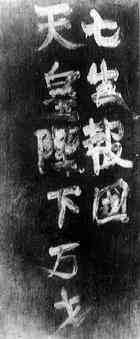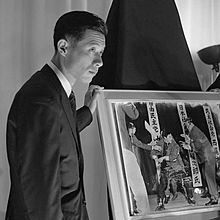|
Otoya Yamaguchi
Otoya Yamaguchi (山口 二矢, Yamaguchi Otoya, 22 February 1943 – 2 November 1960) was a Japanese right-wing ultranationalist youth who assassinated Inejirō Asanuma, chairman of the Japan Socialist Party, on 12 October 1960. Yamaguchi rushed the stage and stabbed Asanuma with a wakizashi-like short sword while Asanuma was participating in a televised election debate at Hibiya Public Hall in Tokyo. Yamaguchi, who was 17 years of age at the time, had been a member of Bin Akao's far-right Greater Japan Patriotic Party, but had resigned earlier that year, just prior to the assassination.[1] After being arrested and interrogated, Yamaguchi committed suicide while in a detention facility. Yamaguchi became a hero and a martyr to Japanese far-right groups, who as of 2022,[2] have continued to hold commemorations to this day.[3] Yamaguchi's actions inspired a number of copycat crimes, including the Shimanaka incident in 1961, and inspired Nobel Prize-winning novelist Kenzaburō Ōe's novellas Seventeen and Death of a Political Youth.[4][5] A photograph of the Asanuma assassination taken by Japanese photojournalist Yasushi Nagao won World Press Photo of the Year for 1960 and the 1961 Pulitzer Prize.[6][7] Early lifeYamaguchi was born on 22 February 1943 in Yanaka, Taitō ward, Tokyo. He was the second son of Shinpei Yamaguchi, who by 1960 would become a high-ranking officer in the Japan Ground Self-Defense Force, and was the maternal grandson of the famous writer Namiroku Murakami, well known for his violent novels glorifying the chivalric code of Japanese organized crime syndicates known as the yakuza.[8] Yamaguchi began reading newspapers starting in his early childhood. Angered by what he read, he became interested in nationalist movements and vehemently critical of politicians. Due to his father's job, he lived in Sapporo, Hokkaido for much of his childhood. In 1958, he was accepted into Tamagawa High School in Tokyo, however his father transferred him to Sapporo Kōsei, a local Catholic school in Sapporo. Yamaguchi then decided to move to Tokyo to live with his brother, and transferred back to Tamagawa High School.[9] Through the influence of his brother, he began attending speeches and participating in protests and counter-protests organized by various right-wing groups.[8] On 10 May 1959, at age 16, he heard a speech by right-wing ultranationalist Bin Akao declaring that Japan was on the verge of a revolution, and that the youth must begin resisting the actions of left-wing groups. This speech had a profound impact on him. After the speech, while Akao was planning to go to the next location, Yamaguchi told Akao that he wanted to go along with him, but Akao gently declined. Following this, he formally joined Akao's Greater Japan Patriotic Party (大日本愛国党, Dai Nippon Aikokutō).[8][9] 1960 Anpo protests Akao was virulently anti-communist and strongly pro-United States. Thus when left-wing protesters, led by Asanuma and the Japan Socialist Party, staged the massive Anpo protests against the 1960 revision of the U.S.-Japan Security Treaty (known as "Anpo" in Japanese), Akao became convinced that Japan was on the verge of a communist revolution and mobilized his followers to stage counter-protests.[10] Yamaguchi participated in these counter-protest activities, and was arrested and released 10 times over the course of 1959 and 1960, within his first six months since joining Akao's party.[9][10] Over the course of his participation in the Anpo protests, Yamaguchi became further disillusioned with Akao's leadership, which he felt was not radical enough.[11] In his testimony to the police after the assassination of Asanuma, Yamaguchi stated that Akao was always talking about taking out left-wing leaders, but was only interested in protests and media coverage, and that Akao would stop him if he ever tried to act on his words. Later in the interview, he stated that he had resigned from Akao's party in order to "lay [his] hands on a weapon" and be free to take more "decisive action."[11] Assassination of Inejirō Asanuma
A note written in the book in Otoya Yamaguchi's Pocket[12]
On 12 October 1960, Yamaguchi was in the large crowd of 2,500 spectators at a televised election debate held in Hibiya Public Hall in Hibiya Park in central Tokyo, featuring Suehiro Nishio of the Democratic Socialist Party, Inejirō Asanuma of the Japan Socialist Party, and Hayato Ikeda of the Liberal Democratic Party. Asanuma was the second to speak, and took the stage at 3:00 p.m. At 3:05 p.m., Yamaguchi rushed onto the stage and made a deep thrust into Asanuma's left flank with the 33-centimeter replica "wakizashi" he had stolen from his father.[note 3] He was subsequently thereafter swarmed and detained by bystanders.[citation needed] Asanuma then died within minutes from massive internal bleeding. At the time of his arrest at the scene of the murder, Yamaguchi had a notebook in his pocket describing Asanuma's actions as unforgivable, as well as detailing his motivations for the attack. In this note, he made mention of political controversy surrounding Asanuma's support for the then recently proclaimed People's Republic of China, the June 15th Incident during the Anpo Protests, as well as concerns over Japan potentially becoming communist.[12] The loss of Asanuma's adroit leadership and the new leadership that followed caused the party to head in a more centrist direction, and deprived the JSP of its ability to present a cohesive message, leading to severe infighting within the party.[14] As a result, the number of seats the socialists held in the Diet continued to decline until the party's extinction in 1996.[15] Imprisonment and suicide Following the assassination, Yamaguchi was arrested and imprisoned awaiting trial. Throughout his incarceration, Yamaguchi remained calm and composed and freely gave extensive testimony to police. He spoke of goals pertaining to causing the restriction of behavior for future left-wing leaders, as well as a desire to negatively influence public perception of left-wing leaders and their ideology.
Otoya Yamaguchi, in his confession to the police
Yamaguchi spoke of Akao respectfully, referring to him using the honorific sensei (先生, master), however, also stating that Akao was more interested in "media attention" and "agitation", as opposed to actively putting his words and ideals to practice. Yamaguchi told police that Akao would have prevented him from carrying out the assassination had he known of his intentions, as well as consistently maintaining that he had acted alone and without any direction from others, stating the inaction on Akao's part as a component of his motivation and reasoning for resigning from the party and committing the offense.
Less than three weeks after the assassination, on 2 November, Yamaguchi mixed a small amount of toothpaste with water and wrote on his cell wall, "Long live the Emperor" (天皇陛下万才, tennōheika banzai) and "Would that I had seven lives to give for my country" (七生報国, shichishō hōkoku), the latter a reference to the famous last words of fourteenth-century samurai Kusunoki Masashige.[3][12] Yamaguchi then knotted strips of his bedsheet into a makeshift rope and used it to hang himself from a light fixture.[3][17] Right-wing groups celebrated Yamaguchi as a martyr; they gave a burial coat, kimono, and belt to his parents and performed a memorial service for him.[18] His ashes were interred in Aoyama Cemetery.[19] Legacy A photograph taken by Yasushi Nagao immediately after Yamaguchi withdrew his sword from Asanuma won the 1961 Pulitzer Prize,[20] and the 1960 World Press Photo award.[7] Footage of the incident was also captured.[21] On 15 December 1960, just weeks after Yamaguchi's suicide, a nationwide coalition of Japanese right-wing groups held a "National Memorial Service for Our Martyred Brother Yamaguchi Otoya" in the same Hibya Public Hall in Tokyo where Yamaguchi had assassinated Asanuma.[3] Since then, right-wing groups have held an annual commemoration of Yamaguchi's death anniversary each year on 2 November.[3] In October 2010, right-wing groups staged a large-scale celebration of the 50th anniversary of Yamaguchi's assassination of Asanuma in Hibiya Park.[18] Yamaguchi's actions and the massive publicity they received inspired a rash of copycat crimes, as a number of political figures became targets of assassination plots and attempts over the next few years.[3] Of the notable crimes inspired by Yamaguchi's attack, one was the Shimanaka Incident of 1 February 1961. In this incident, Kazutaka Komori, a 17-year-old member of the Greater Japan Patriotic Party, attempted to assassinate the president of Chūō Kōron magazine for publishing a graphic dream sequence depicting the beheading of the emperor and his family. This played a role in establishing what came to be known as the Chrysanthemum taboo.[22][23] Japanese author Kenzaburō Ōe based his 1961 novellas Seventeen and Death of a Political Youth on Yamaguchi.[5] NotesFootnotes
Original Japanese textBelow is the original, untranslated transcriptions from various statements made by the subject of this article.
References
Further reading
|
||||||||||||||||
